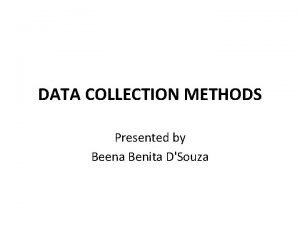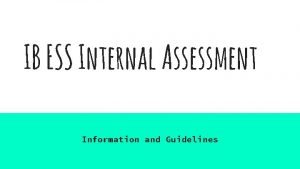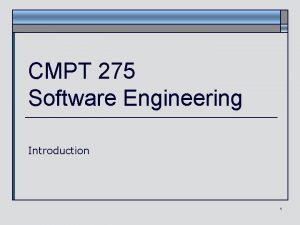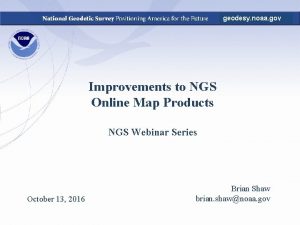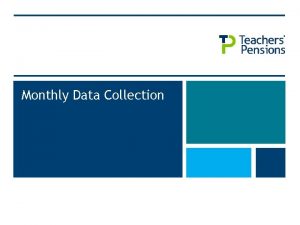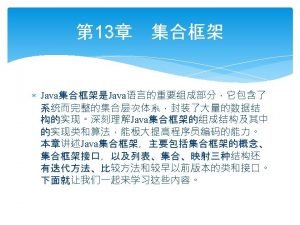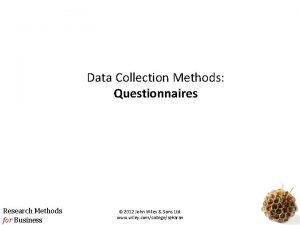CHAPTER 9 SURVEY DATA COLLECTION METHODS Important Topics































- Slides: 31

CHAPTER 9 SURVEY DATA COLLECTION METHODS

Important Topics of This Chapter • To understand survey research techniques. • Types of errors in survey research. • To discover the advantages and disadvantages of survey research. • To understand advantages and disadvantages of internet research. • To understand the factors that determine the choice of particular survey methods. • Importance of the marketing research interviewer. • To learn the differences between domestic and international survey research.

A Classification of Survey Methods Telephone Personal In-Home Traditional Telephone Mall Intercept Computer-Assisted Telephone Interviewing Mail Computer-Assisted Personal Interviewing Mail Interview Electronic E-mail Mail Panel Internet

Reasons for the Popularity of Surveys • The Need to Know Why • In marketing research there generally is a critical need to have some idea about why people do or do not do something. • The Need to Know How • At the same time, the marketing researcher often finds it necessary to understand the process consumers go through before taking some action.

Reasons for the Popularity of Surveys • The Need to Know Who • The marketing researcher also needs to know who the person is from a demographic or lifestyle perspective. • Information on age, income, occupation, marital status, stage in the family life cycle, education, and other factors is necessary to the identification and definition of market segments.

Errors in Survey Research When assessing the quality of information obtained from survey research, the manager must make some determination of the accuracy of those results. The various types of errors that might be encountered in a survey are shown in the following several slides.

Sampling Error • Two types of errors may be encountered in connection with the sampling process: • Measurement error. • Systematic error.

Measurement Error • Measurement error occurs when there is a variation between the information being sought (true value) and the information obtained by the measurement process. • Types of Measurement Error: • Surrogate Information Error: – Occurs when there is a discrepancy between the information actually required to solve a problem and the information being sought by the researcher.

Measurement Error (cont. ) • Types of Measurement Error (continued) • Interviewer Error: – Is due to interactions between the interviewer and the respondent. The interviewer may, consciously or unconsciously, influence respondents to give untrue or inaccurate answers. – Measurement Error Bias. – Is the result of problems with the measurement instrument or questionnaire.

Measurement Error(cont. ) • Types of Measurement Error (continued) • Processing Error – Processing errors are primarily caused by mistakes in the transfer of information from survey documents or respondents’ replies to the computer. – Non-response Bias – The potential systematic difference between the people who do and the people who do not respond to a survey. • Response Bias – If there is a tendency for people to answer a particular question in a certain way, then response bias is taking place.

Systematic Error • Systematic error, or bias, results from mistakes or problems in the research design or from flaws in the execution of the sample design. • As a result, systematic error includes all sources of error except those introduced by the random sampling process: • Therefore, systematic errors or bias are sometimes called non-sampling errors.

Systematic Error (cont. ) • Sample design results may be biased for a number of reasons: • Frame Error: – Results from using an incomplete or inaccurate sampling frame. • Population Specification Error: – Results from an incorrect definition of the universe or population from which the sample is to be selected. • Selection Error: – Can occur even when the analyst has a proper sample frame and has defined the population correctly.

Types of Surveys • Door-To-Door Interviewing • Interviews conducted face to face with consumers in their homes. • Mall Intercept • Interviews conducted in public areas of malls by intercepting shoppers and interviewing them face-to face.

Types of Surveys (cont. ) • Executive Interviewing • The industrial equivalent of door-to-door interviewing. • Telephone Interviewing • Interviewing respondents over the telephone. • Central Location Telephone Interviews • Interviews conducted through calls to respondents from a centrally located marketing research facility.

Types of Surveys • Computer Assisted Telephone Interviewing (CITI) • Central location telephone interviewing in which the interviewer enters answers directly into a computer. • IVR Automated Telephone Surveys • A recent development that simplifies telephone surveys by using interactive voice response technology to conduct interviews.

Random Digit Directory Designs Adding a Constant to the Last Digit: • An integer between 1 and 9 is added to the telephone number selected from the directory. In plus-one sampling the number added to the last digit is 1. • Number selected from directory: 953 -3004 (exchangeblock). Add one to the last digit to form 953 -3005. This is the number to be included in the sample. Randomizing the r Last Digits: • Replace the r (r = 2, 3, or 4) last digits with an equal number of randomly selected digits. • Number selected from directory: 881 -1124. Replace the last four digits of the block with randomly selected numbers 5, 2, 8, and 6 to form 881 -5286.

Two-Stage Procedure: • The first stage consists of selecting an exchange and telephone number from the directory. In the second stage, the last three digits of the selected number are replaced with a three-digit random number between 000 and 999. Cluster 1: • Selected exchange: 636 • Selected number: 636 -3230 • Replace the last three digits (230) with randomly selected 389 to form 636 -3389. • Repeat this process until the desired number of telephone numbers from this cluster is obtained.

Types of Surveys • Direct Computer Interviewing • Interviews conducted by a computer that asks questions and accepts responses. • Self-Administered Interview • Questionnaire filled out by the respondent with no interviewer present.

Types of Surveys • Mail Surveys – Ad Hoc Mail Surveys: • Questionnaires for a particular project sent to selected names and addresses with no prior contact by the researcher. – Mail Panels: • Pre-contacted and screened participants who are periodically sent questionnaires. • A mail panel is a type of longitudinal study. A longitudinal study in one in which the same respondents are resampled over time.

Some Decisions Related to the Mail Survey Outgoing Envelope Outgoing envelope: size, color, return address Postage Method of addressing Cover Letter Sponsorship Type of appeal Postscript Personalization Signature Questionnaire Length Size Layout Format Content Reproduction Color Respondent anonymity Return Envelope Type of envelope Postage Incentives Monetary versus non-monetary Prepaid versus promised amount

Sample Mailing Lists List Title Advertising agencies Banks, branches Boat owners Chambers of Commerce Personal computer owners Families Hardware wholesalers Magazines, consumers Photographic, portrait Sales executives Wives of professional men YMCA’s Number on List 3892 11089 4289601 6559 2218672 76000000 7378 4119 33742 190002 1663614 1036 * Price shown is per 1000 names (/M), except where noted. Price $45/M $85/M $50/M $45/M Inquire $45/M $55/M $60/M $85

Tactics Employed to Increase Mail Survey Response Rate • Advance postcard or telephone call alerting respondent of survey. • Follow-up postcard or phone call. • Monetary incentives (nickel, dime, quarter, half-dollar). • Premiums (pencil, pen, key chain, etc. ). • Postage stamps rather than metered envelopes. • Self-addressed, stamped return envelope. • Personalized address and well-written cover letter.

Tactics Employed to Increase Mail Survey Response Rate • Entry into drawing for prize. • Emotional appeals. • Affiliation with universities or research institutions. • Personally signed cover letter. • Multiple mailings of the questionnaire. • Reminder that respondent participated in previous study.

Internet Surveys Advantages - Speed with which a survey can be distributed and collected. Disadvantages - Internet users are not representative of the population as a whole - Ability to reach a lot of people - Security - Potential for longitudinal studies - Surveys can be unobtrusively included with a general site - Low cost - Can be made visually pleasing - Anyone can participate in unrestricted sites

Other Issues Involving Internet Surveys • Internet Samples: • Unrestricted: – Open to any Internet user. • Screened: – Adjust for the unrepresentativeness of the self-selected respondents by imposing quotas based on some desirable sample characteristics. – Recruited Internet samples are used for target populations in surveys that require more control over the make-up of the sample.

Other Issues Involving Internet Surveys(cont. ) • Methods of Conducting Internet Surveys • E-mail Questionnaires – The questionnaire is prepared like a simple E-mail message, and is sent to a list of known E-mail addresses. The respondent fills in the answers, and E-mails the form plus replies back to the research organization • Converted CATI Systems – A software translator program takes questionnaires programmed in the CATI vendor’s questionnaire construction language and translates them for distribution over the Web. • Web Survey Systems – These are software systems specifically designed for Web questionnaire construction and delivery. They consist of an integrated questionnaire designer, Web server, database, and data delivery program designed for use by non-programmers.

Factors Determining Choice of Particular Survey Methods • Researcher’s Resources and Objectives: • Survey Data collection time horizon: – How accurate do the study results need to be? If the need for accuracy is not great, less rigorous and less expensive sampling procedures may be appropriate. – Time available to complete the research • Budget Available: – How much money is available for the interviewing portion of the study? • Quality of Data Required: – How accurate do the results of the study need to be? • Length of Questionnaire: – Long questionnaires are difficult to do by mail, over the phone, in a mall, etc.

Factors Determining Choice of Particular Survey Methods(cont. ) • Respondent Characteristics: • Incidence Rate: – Representative sample. – Are you looking for people who make up 1 percent of the total population or 50 percent of the population? If you are looking for a needle in a haystack, you need an inexpensive way to find it. – Degree of Structure of Questionnaire – Highly unstructured questionnaires may require data collection by the door-to-door approach.

Factors Determining Choice of Particular Survey Methods(cont. ) • Willingness to participate: – Refusal rate. – Monetary incentives. – Drop-off method. • Ability to participate: – Screening with telephone interview. – Background check. . • Necessity of Having Respondent Perform Certain Specialized Tasks: – Card sorts, and the like require face-to-face contact.

Factors Determining Choice of Particular Survey Methods(cont. ) • Characteristics of Questions Asked by Respondents: • Complexity of tasks: – Taste test. – Advertising recall test. • Amount of information required: – Telephone survey Vs. personal interview. • Topic sensitivity: – Personal and confidential information.

SURVEY RESEARCH IN THE INTERNATIONAL MARKET • European Marketing Research. • Asian Marketing Research. • Conducting International Research: • Willingness to Participate. • Language and Comprehension. • Solution of the Problems.
 Survey method of data collection
Survey method of data collection Survey data collection
Survey data collection Types of data collection methods
Types of data collection methods Tools how to legal research
Tools how to legal research Observational data collection methods
Observational data collection methods Data collection methods observation
Data collection methods observation Primary data and secondary data
Primary data and secondary data Automated data collection methods
Automated data collection methods Ess ia topics 2020
Ess ia topics 2020 Software engineering important topics
Software engineering important topics Primary survey secondary survey
Primary survey secondary survey Landsat collection 1 vs collection 2
Landsat collection 1 vs collection 2 D/a 30 days
D/a 30 days Procedures of data collection
Procedures of data collection The terms external secondary data and syndicated
The terms external secondary data and syndicated Od survey methods
Od survey methods Collection methods and procedures
Collection methods and procedures From most important to least important in writing
From most important to least important in writing Inverted pyramid in news writing
Inverted pyramid in news writing Least important to most important
Least important to most important Direct and indirect wax pattern
Direct and indirect wax pattern Data warehouse research topics
Data warehouse research topics Data management topics
Data management topics Chapter 9 topics in analytic geometry
Chapter 9 topics in analytic geometry Ssdmv2
Ssdmv2 Seabed survey data model
Seabed survey data model National geodetic survey data explorer
National geodetic survey data explorer Ncd jhs telangana gov in
Ncd jhs telangana gov in Survey data analysis in stata
Survey data analysis in stata Coding survey data
Coding survey data Longitudinal survey data analysis
Longitudinal survey data analysis Type of data collected in quantitative research
Type of data collected in quantitative research





